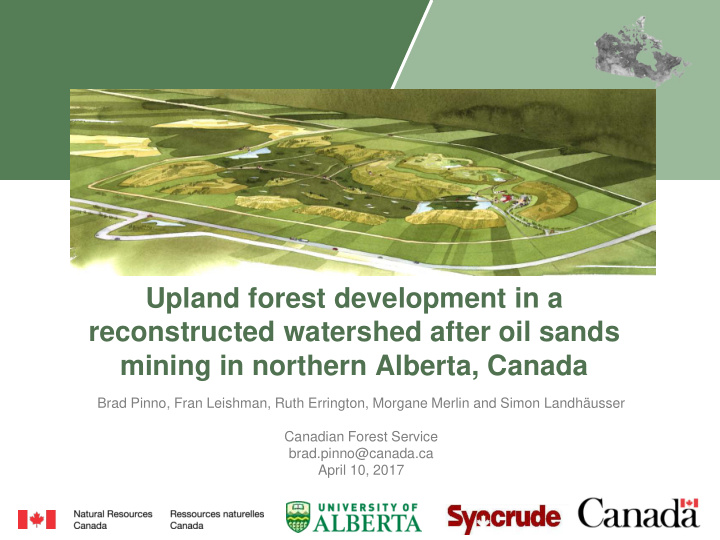



Upland forest development in a reconstructed watershed after oil sands mining in northern Alberta, Canada Brad Pinno, Fran Leishman, Ruth Errington, Morgane Merlin and Simon Landhäusser Canadian Forest Service brad.pinno@canada.ca April 10, 2017
Oil Sands in Alberta Oil sands are in 3 main deposits in Alberta Mining used north of Fort McMurray, in-situ extraction used everywhere else Mining occurs where the oil deposit is thick and close to the surface, i.e. near the Athabasca River north of Fort McMurray Most of the rest of Alberta is underlain by conventional oil and gas deposits The cumulative impacts of oil & gas development, forestry, Mines are where agriculture, recreation, other overburden is human uses and natural shallow. disturbances are very significant in Alberta
Alberta’s regulatory context Public land Requirements to reclaim wetlands and uplands but the landscape will be different Equivalent land capability Focus on ecosystem function rather than productivity Locally common species Novel ecosystems
Natural landscape Boreal forest on the interior plains Half uplands, half wetland bogs and fens Sedge dominated fen Tamarack and Borderline sub-arctic black spruce bog climate Moisture limited environment (455 mm) Soil storage dominates the water cycle Aspen-spruce mixedwood Jack pine on xeric on mesic sites sites
Reclaimed watersheds Priority for future reclamation is integrated upland – wetland watersheds Research in natural forests has highlighted the importance of wetlands for upland forest growth Natural lake surrounded by reclaimed forest Reclaimed landscape will have more uplands and ponds but fewer bogs/fens than original landscape How is water partitioned between uplands and wetlands in this dry environment? Wetland establishment research project The same volunteer wetland 1 and 4 growing seasons after reclamation. These micro-wetlands form due to reclamation material subsidence and may be critical landscape features for keeping water on reclaimed areas.
Sandhill Fen Watershed Reconstructed wetland – upland watershed 50 ha in total size Old mine pit filled with tailings sand Hummocks to create uplands, wetland in lower areas Hummocks capped with salvaged forest soils Hummock Goal is to create a functioning upland-wetland ecosystem Linkages between the uplands and wetland portions Integrated research project but focus here on the upland forest Wetland
2011 - Construction 2011 - construction Photo from Syncrude
2013 Photo from Syncrude
2014 2014 Photo from Syncrude
Upland vegetation study 2 soil types coarse and fine textured 2 main tree species Trembling aspen and jack pine 3 planting densities 0, 5,000, and 10,000 sph Environmental variables Tree growth Understory development
Soil water potential Coarse textured Fine textured No difference between soils early on Soil moisture closely follows precipitation As vegetation develops the fine textured soil becomes progressively drier Reconstructed soil profile with water potential sensors
Tree density and water High tree density results in lower water potential Longer term implications of how much leaf area these sites can support Coarse textured Fine textured Medium density pine in the foreground, high density in the back
Soil nutrient supply Total Nitrogen Phosphorous Potassium ug/10cm²/burial time 70 30 600 Coarse Fine 60 500 ns ns ns * * * * * * 50 20 400 40 300 30 10 200 20 100 10 0 0 0 2012 2013 2016 2012 2013 2016 2012 2013 2016 Lower availability of P and K in the fine textured soils Inorganic nitrogen did not vary over time or by soil
Trees Trembling aspen and jack pine 0, 5,000, and 10,000 sph planting densities Growth and water use High density jack pine planting after year 1 and year 5 Trembling aspen Jack pine
Tree growth Greater growth on fine textured soils, difference becoming greater over time Trembling aspen has more variable growth
Pine growth varies with aspect Height Growth (c 90 Pine larger on north 80 A B A 70 facing plots 60 Cooler and wetter sites 50 40 Aspen growth not 30 20 influenced by aspect or 10 0 planting density at this Flat North South time Aspect
Tree water use (Stomatal conductance) Aspen has high water use and does not respond to soil Jack pine is more responsive to soil conditions Link to the long term water balance of the site
Plant community composition Axis 2 Fine textured Coarse textured graminoids Axis 1 shrubs bryophytes trees forbs
Understory species richness Species Richness per Subplot Shrub 10 Total number of species Similar species richness Graminoid • 2012 – 113 • 2013 – 180 Forb between soil types • 2015 – 140 8 Coarse soil → grasses Fine soil → forbs 6 More introduced species 4 on fine textured soil Higher diversity with 2 higher density planting treatments and with north 0 facing aspects Native Introduced Native Introduced Coarse - xeric Fine - mesic
Understory vegetation cover Higher vegetation 10 15 20 25 30 Vegetation Cover (%) cover on fine textured Shrub soil, particularly native Graminoid forbs Forb Higher shrub cover on coarse textured soil Pin cherry 5 0 Native Introduced Native Introduced Coarse textured Fine textured
Vegetation development (LAI) Leaf Area Index (cm²/cm²) 8 Higher overall leaf area Coarse textured PX RM Fine textured on fine textured soil 6 Difference is increasing over time 4 Tree leaf area 2 becoming a more important component, 0 particularly in high 2012 2013 2014 2015 2016 density plantings Capping significant
Next steps How are soils, water, plants and trees interacting? How are the uplands and wetlands interacting? How are reclaimed ecosystems developing? Structural equation modelling
Operational implications Sandhill Fen Kingfisher Watershed • Currently in construction East In Pit • 100s of ha of tailings to be reclaimed in the 1,000s more ha of coming decades tailings to be reclaimed across the mine lease and the mineable oil sands region
Thanks!
Recommend
More recommend